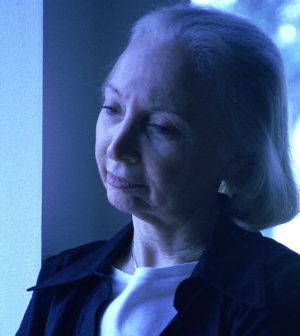- Calories, Not Meal Timing, Key to Weight Loss: Study
- Dietary Changes May Beat Meds in Treating IBS
- Screen Pregnant Women for Syphilis, Ob-Gyn Group Advises
- Even With Weight Gain, Quitting Smoking in Pregnancy Still Best for Health
- A-Fib Is Strong Precursor to Heart Failure
- One Neurological Factor Keeps Black, Hispanic Patients From Alzheimer’s Clinical Trials
- Managing Blood Sugar After Stroke Could Be Key to Outcomes
- Dozens of COVID Virus Mutations Arose in Man With Longest Known Case
- Blood Test Might Someday Diagnose Early MS
- Check Your Fridge for Trader Joe’s Fresh Basil, Linked to Salmonella
The Right Lighting Can Calm Alzheimer’s Patients

Lighting that mimics natural night-day patterns might improve sleep and mood problems for Alzheimer’s patients living in nursing homes, new research suggests.
The lighting intervention, designed to stimulate dementia patients’ circadian rhythm — which regulates sleep and wake cycles — led to significant decreases in sleep disturbance, depression and agitation, the study authors said.
“One of the main reasons Alzheimer’s disease patients are institutionalized is lack of sleep and behavior issues,” explained study author Mariana Figueiro. She directs the Lighting Research Center at Rensselaer Polytechnic Institute in Troy, N.Y.
“This is a very simple solution,” Figueiro added. “It has worked with over half of patients, if not more. Even if it can help half of the people exposed to [the light], that’s a pretty good outcome.”
In addition to thinking and memory problems, dementia patients typically experience symptoms such as sleep disturbance, irritability, anxiety and wandering. An estimated 5.7 million Americans have Alzheimer’s disease, the most common form of dementia, according to the Alzheimer’s Association.
No medications have been approved by the U.S. Food and Drug Administration specifically to treat these symptoms in Alzheimer’s patients, according to the researchers. All drugs currently available are used “off-label” for these purposes.
Figueiro and her team tested the lighting interventions on 43 nursing home residents in three states for four weeks, and 37 nursing home residents for six months. The tailored lighting included either a custom-designed LED light table or individual room lighting, depending on where patients spent most of their time during the day. Personal light meters monitored the patients’ exposures.
The lighting was designed to stimulate the body’s circadian rhythm, which prompts the release of the hormone melatonin in the brain that regulates normal sleep-wake cycles. Because nursing home residents are often exposed to varying levels of artificial light at all hours of the day and night, these sleep-wake patterns can be disrupted, study authors noted.
At the end of four weeks, sleep disturbance and depression scores in patients exposed to the tailored light intervention declined significantly. By the end of six months, sleep disturbance scores were lowered by about half. Depression scores among the light-exposed were less than half of baseline levels, on average, the researchers reported.
Dr. Joseph Masdeu, director of the Houston Methodist Nantz National Alzheimer Center in Texas, wasn’t surprised by the findings.
“If you put these patients in an environment where light is present all day [and night], their system is more prone to be confused than in people who are healthy,” said Masdeu, who wasn’t involved with the research. “If you correct this problem, you may be contributing to their well-being.”
It shouldn’t be expensive for nursing homes and other facilities that serve dementia patients to install lighting like that used in the research, Figueiro said.
Several years ago, she said, “one of the barriers was technology. LEDs are much easier now … one of the barriers is cost, but it’s going down, so I’m hoping in the next couple of years we’ll see this more.”
Figueiro also suggested that nursing home staffers bring patients outdoors more often to take advantage of natural light and to install skylights and other architectural features that bring more light inside.
“Hopefully we’ll entice people to think of this issue differently,” Figueiro said.
The study is scheduled for presentation Tuesday at the Alzheimer’s Association annual meeting, in Chicago. Research presented at scientific conferences typically hasn’t been peer-reviewed or published, and results are considered preliminary.
More information
The U.S. National Sleep Foundation has more on circadian rhythms.
Source: HealthDay
Copyright © 2024 HealthDay. All rights reserved.










